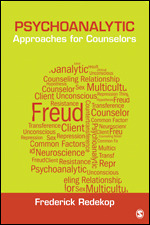Introduction
The Relevance of Psychoanalysis
Inauguration: To Mark the Beginning of a New Period, Style, or Activity
Starting With the Two Most Important Common Factors: The Client and the Counseling Relationship
Freud Versus Freud: What Did He Actually Do?
Freud’s Goody-goods: The Necessity of Collaboration
Constructing a Counselor-Friendly Freud
The Cause(s) of Mental Illness
Transference and Countertransference
Chapter 1: The Talking Cure
The First Client: Bertha Pappenheim
Intensive, Ongoing Treatment
Listening to Pappenheim With Sympathy and Interest
Pappenheim’s Contemporary Importance
Did Breuer Truly “Get” Pappenheim?
Empathic Listening and Interpretation
Pappenheim’s Amazing Transformation
Primum Non Nocere—Above All, Do No Harm
“The True Vehicle of Therapeutic Influence”
The Therapeutic Relationship: What’s It Really Like?
Chapter 2: Basic Psychoanalytic Concepts
How the Mind Works: The Structural Model and the Topographical Model
How People—and Problems—Develop
Freud’s Mechanisms of Defense
Displacement and Projection
Reaction Formation, Rationalization/Intellectualization, Introjection, Identification, Regression
Don’t Forget: Sex Can Be Fun!
The Therapeutic Aim of Psychoanalysis
Progress, Slow and Steady
The Tools of Psychoanalysis: The Background of Freud’s Technique
The Return of Rest Cures, Electrotherapy, and Psychopharmacology
You Are Getting Very Sleepy…
No Wait—Your Eyes Aren’t Closing—They are Moving!
To What Degree Must We Abstain?
Recommendations, Not Rules
The Tools of Psychoanalysis: Interventions to Accomplish Its Aim
Transference, Pros and Cons
Slips of the Tongue, Jokes, and Habitual Actions
Rounding Out the Picture: King Oedipus, Sex/Love and Aggression/Death, the Nature of Trauma, and Other Freudian Controversies
Could This Story Tell Us Anything About Freud?
Was Freud Sexualized at an Early Age?
Chapter 3: The Evolution of Psychoanalysis
Object Relations and Interpersonal Psychoanalysis
Neuroscience and Psychoanalysis
The Development of the Emotional Self
An Illustration: Daddy Day Care
Counseling as a Corrective Affective (and Cognitive) Experience
Chapter 4: Multiculturalism
“My Parents Were Jews, and I Have Remained a Jew Myself”
Social Class: Is Psychoanalysis Just For Rich People?
Practical Matters First: Money
A Theoretical Concern: Who Has Time for Insight?
Theoretical Concern Number Two: Who Has the Necessary Ego Strength?
Recent Scholarship: The Free Clinics
Psychoanalysis as Failed Feminism
Are Men and Women Really Different?
Empirical Research to the Rescue
Ethics of Rights, Ethics of Care, and Difference Feminism
Psychological Adjustment and Societal Change
Chapter 5: A Case Illustration of Contemporary Psychoanalytic Counseling
Session One: Getting to Know Jennie
Sessions Two to Four: The Growth of the Counseling Relationship
Sessions Five and Six: The Usual Detours
Session Seven: The Big Dream
Session Eight: How Should I Respond?
Session Nine: The Time is Right
Session Ten (and Beyond): On the Journey, Together
Chapter 6: Conclusion
The Unconscious, Version 2.0
The Client Is the Most Important Person in the Room

